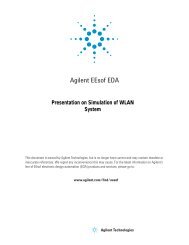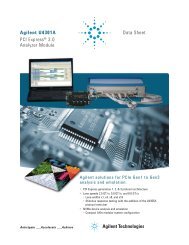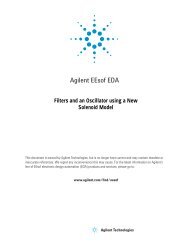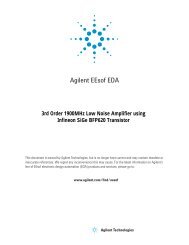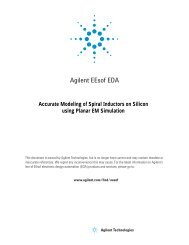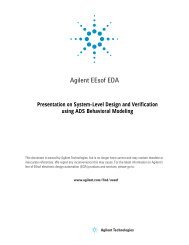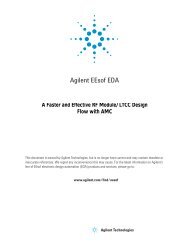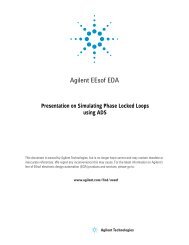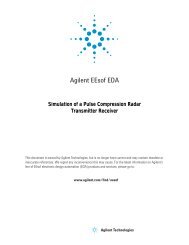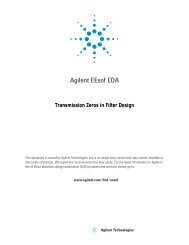Agilent 34970A/34972A Data Acquisition / Switch Unit
Agilent 34970A/34972A Data Acquisition / Switch Unit
Agilent 34970A/34972A Data Acquisition / Switch Unit
You also want an ePaper? Increase the reach of your titles
YUMPU automatically turns print PDFs into web optimized ePapers that Google loves.
Chapter 4 Calibration Procedures<br />
Test Considerations<br />
Test Considerations<br />
To ensure proper instrument operation, verify that you have selected the<br />
correct power line voltage prior to attempting any procedure in this<br />
chapter. See “If the Instrument Does Not Turn On”, on page 50.<br />
Errors may be induced by AC signals present on the input leads during a<br />
self-test. Long test leads can also act as an antenna causing pick-up of<br />
AC signals.<br />
For optimum performance, all procedures should comply with the<br />
following recommendations:<br />
• Assure that the calibration ambient temperature is stable and<br />
between 18 °C and 28 °C. Ideally the calibration should be performed<br />
at 23 °C ±1 °C.<br />
• Assure ambient relative humidity is less than 80%.<br />
• Allow a 2-hour warm-up period with a copper short connected and the<br />
multiplexer module installed before verification or adjustment.The<br />
connections are shown in the figure on page 76.<br />
• Use shielded twisted pair PTFE insulated cables to reduce settling<br />
and noise errors. Keep the input cables as short as possible.<br />
• Connect the input cable shield to the source LO output.Except where<br />
noted in the procedures, connect the calibrator LO source to earth<br />
ground.<br />
Two-wire Ohms measurements are affected by the entire path length,<br />
including the plug-in card trace length and slot trace lengths. On the<br />
34901A, Channel 10 is recommended as the median path length (on the<br />
34902A, use Channel 8) for 2-wire Ohms verification and adjustments.<br />
Install the input multiplexer in slot 200.<br />
Because the instrument is capable of making highly accurate<br />
measurements, you must take special care to ensure that the calibration<br />
standards and test procedures used do not introduce additional errors.<br />
Ideally, the standards used to verify and adjust the instrument should be<br />
an order of magnitude more accurate than each instrument range full<br />
scale error specification.<br />
For the DC voltage, DC current, and resistance gain verification<br />
measurements, you should take care to ensure the calibrator’s “0” output<br />
is correct. If necessary, the measurements can be referenced to the<br />
calibrator’s “0” output using Mx + B scaling (see page 64). You will need<br />
to set the offset for each range of the measuring function being verified.<br />
4<br />
81





